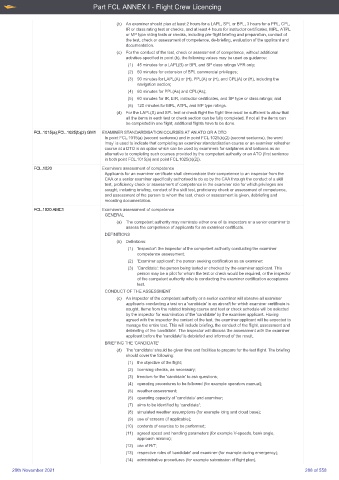Page 288 - UK Aircrew Regulations (Consolidated) 201121
P. 288
Part FCL ANNEX I - Flight Crew Licencing
(b) An examiner should plan at least 2 hours for a LAPL, SPL or BPL, 3 hours for a PPL, CPL,
IR or class rating test or checks, and at least 4 hours for instructor certificates, MPL, ATPL
or MP type rating tests or checks, including pre-flight briefing and preparation, conduct of
the test, check or assessment of competence, de-briefing, evaluation of the applicant and
documentation.
(c) For the conduct of the test, check or assessment of competence, without additional
activities specified in point (b), the following values may be used as guidance:
(1) 45 minutes for a LAPL(B) or BPL and SP class ratings VFR only;
(2) 60 minutes for extension of BPL commercial privileges;
(3) 90 minutes for LAPL(A) or (H), PPL(A) or (H), and CPL(A) or (H), including the
navigation section;
(4) 60 minutes for PPL(As) and CPL(As);.
(5) 60 minutes for IR, EIR, instructor certificates, and SP type or class ratings; and
(6) 120 minutes for MPL, ATPL, and MP type ratings.
(d) For the LAPL(S) and SPL test or check flight the flight time must be sufficient to allow that
all the items in each test or check section can be fully completed. If not all the items can
be completed in one flight, additional flights have to be done.
FCL.1015(a);FCL.1025(b)(2) GM1 EXAMINER STANDARDISATION COURSES AT AN ATO OR A DTO
In point FCL.1015(a) (second sentence) and in point FCL.1025(b)(2) (second sentence), the word
‘may’ is used to indicate that completing an examiner standardisation course or an examiner refresher
course at a DTO is an option which can be used by examiners for sailplanes and balloons as an
alternative to completing such courses provided by the competent authority or an ATO (first sentence
in both point FCL.1015(a) and point FCL.1025(b)(2)).
FCL.1020 Examiners assessment of competence
Applicants for an examiner certificate shall demonstrate their competence to an inspector from the
CAA or a senior examiner specifically authorised to do so by the CAA through the conduct of a skill
test, proficiency check or assessment of competence in the examiner role for which privileges are
sought, including briefing, conduct of the skill test, proficiency check or assessment of competence,
and assessment of the person to whom the test, check or assessment is given, debriefing and
recording documentation.
FCL.1020 AMC1 Examiners assessment of competence
GENERAL
(a) The competent authority may nominate either one of its inspectors or a senior examiner to
assess the competence of applicants for an examiner certificate.
DEFINITIONS
(b) Definitions:
(1) 'Inspector': the inspector of the competent authority conducting the examiner
competence assessment;
(2) 'Examiner applicant': the person seeking certification as an examiner;
(3) 'Candidate': the person being tested or checked by the examiner applicant. This
person may be a pilot for whom the test or check would be required, or the inspector
of the competent authority who is conducting the examiner certification acceptance
test.
CONDUCT OF THE ASSESSMENT
(c) An inspector of the competent authority or a senior examiner will observe all examiner
applicants conducting a test on a 'candidate' in an aircraft for which examiner certificate is
sought. Items from the related training course and test or check schedule will be selected
by the inspector for examination of the 'candidate' by the examiner applicant. Having
agreed with the inspector the content of the test, the examiner applicant will be expected to
manage the entire test. This will include briefing, the conduct of the flight, assessment and
debriefing of the 'candidate'. The inspector will discuss the assessment with the examiner
applicant before the 'candidate' is debriefed and informed of the result.
BRIEFING THE 'CANDIDATE'
(d) The 'candidate' should be given time and facilities to prepare for the test flight. The briefing
should cover the following:
(1) the objective of the flight;
(2) licensing checks, as necessary;
(3) freedom for the 'candidate' to ask questions;
(4) operating procedures to be followed (for example operators manual);
(5) weather assessment;
(6) operating capacity of 'candidate' and examiner;
(7) aims to be identified by 'candidate';
(8) simulated weather assumptions (for example icing and cloud base);
(9) use of screens (if applicable);
(10) contents of exercise to be performed;
(11) agreed speed and handling parameters (for example V-speeds, bank angle,
approach minima);
(12) use of R/T;
(13) respective roles of 'candidate' and examiner (for example during emergency);
(14) administrative procedures (for example submission of flight plan).
20th November 2021 288 of 558

